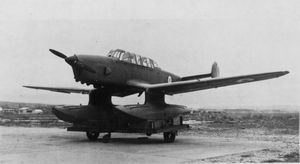Catalogue number 126096
Dewoitine HD730
The prototype reconnaisance floatplane, armed with two 7.5mm machine guns, to be embarked on warships of the French Navy. Note twin tail and inverted gullwing wings, aircraft on launching trolly. The two prototypes flew in 1940 but, as for the H780, the Armistice eventually brought further develpment to a halt.
Credt: PhotoArchives U.P.E.
11.7cm x 6.4cm Gelatin silver print
|
 |